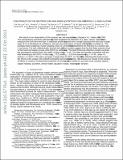CONSTRAINTS ON THE NEUTRON STAR AND INNER ACCRETION FLOW IN SERPENS X-1 USING
Author(s)
Miller, J. M.; Parker, M. L.; Fuerst, F.; Bachetti, Matteo; Barret, Didier; Grefenstette, Brian W.; Tendulkar, S.; Harrison, Fiona A.; Boggs, Steven E.; Chakrabarty, Deepto; Christensen, Finn E.; Craig, William W.; Fabian, Andrew C.; Hailey, Charles J.; Natalucci, Lorenzo; Paerels, F. B. S.; Rana, V.; Stern, D. K.; Tomsick, J. A.; Zhang, W. W.; ... Show more Show less
DownloadChakrabarty_Constraints on.pdf (247.7Kb)
OPEN_ACCESS_POLICY
Open Access Policy
Creative Commons Attribution-Noncommercial-Share Alike
Terms of use
Metadata
Show full item recordAbstract
We report on an observation of the neutron star low-mass X-ray binary Serpens X-1, made with NuSTAR. The extraordinary sensitivity afforded by NuSTAR facilitated the detection of a clear, robust, relativistic Fe K emission line from the inner disk. A relativistic profile is required over a single Gaussian line from any charge state of Fe at the 5σ level of confidence, and any two Gaussians of equal width at the same confidence. The Compton back-scattering "hump" peaking in the 10-20 keV band is detected for the first time in a neutron star X-ray binary. Fits with relativistically blurred disk reflection models suggest that the disk likely extends close to the innermost stable circular orbit (ISCO) or stellar surface. The best-fit blurred reflection models constrain the gravitational redshift from the stellar surface to be z [subscript NS] ≥ 0.16. The data are broadly compatible with the disk extending to the ISCO; in that case, z [subscript NS] ≥ 0.22 and R [subscript NS] ≤ 12.6 km (assuming M [subscript NS] = 1.4 M [subscript ☉] and a = 0, where a = cJ/GM [superscript 2]). If the star is as large or larger than its ISCO, or if the effective reflecting disk leaks across the ISCO to the surface, the redshift constraints become measurements. We discuss our results in the context of efforts to measure fundamental properties of neutron stars, and models for accretion onto compact objects.
Date issued
2013-12Department
Massachusetts Institute of Technology. Department of Physics; MIT Kavli Institute for Astrophysics and Space ResearchJournal
Astrophysical Journal
Publisher
American Astronomical Society
Citation
Miller, J. M., M. L. Parker, F. Fuerst, M. Bachetti, D. Barret, B. W. Grefenstette, S. Tendulkar, et al. “ CONSTRAINTS ON THE NEUTRON STAR AND INNER ACCRETION FLOW IN SERPENS X-1 USING NuSTAR .” The Astrophysical Journal 779, no. 1 (December 10, 2013): L2.
Version: Original manuscript
ISSN
2041-8205
2041-8213